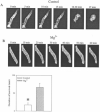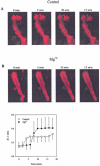Mg2+ protects adult beating cardiomyocytes against ischaemia
- PMID: 18097618
- PMCID: PMC2174030
Mg2+ protects adult beating cardiomyocytes against ischaemia
Abstract
Although Mg2+ reduces infarct size in whole heart models of ischaemia/reperfusion, the cardioprotective effect of Mg2+ at the cellular level is still a controversial issue. Therefore, we tested whether Mg2+ protects cardiomyocytes against ischaemia. To accomplish this aim we used an experimental model of ischaemia that utilises single beating adult cardiomyocytes in which oxygen tension is tightly regulated without the use of oxygen scavengers or metabolic inhibitors. Taking all these into consideration, this model is probably closer to in vivo conditions than the majority of previously published cellular models of ischaemia. We found that the addition of extracellular Mg2+ (8 mM) increased the survival of cells exposed to ischaemia. As sarcolemma and mitochondria are end-effectors of cardioprotective signalling, we examined whether Mg2+ regulates sarcolemmal and mitochondrial events. Mg2+ (8 mM) did not affect the whole cell K+ current as revealed by patch clamp electrophysiology. Experiments with laser confocal microscopy and the mitochondrial membrane potential-sensitive dye, JC-1, showed that Mg2+ (8 mM) did not affect ischaemia-induced mitochondrial membrane depolarisation. However, a significantly lower JC-1 ratio was required to kill cells under control conditions than cells treated with Mg2+ (8 mM). Based on the obtained data, we conclude that Mg2+ protects single beating cardiomyocytes against ischaemia by increasing cellular resistance to the consequences of mitochondrial membrane depolarisation in the cytosol.
Figures




References
-
- Schmitz C, Perraud AL, Fleig A, Scharenberg AM. Dual-function ion channel/protein kinases: novel components of vertebrate magnesium regulatory mechanism. Pediatr Res. 2004;55:734–737. - PubMed
-
- Ebrahimi S, Faghihi M, Keshavarz M, Kadkhodaee M, Mirershadi F, Asadi B. Anti-infarct effect of magnesium is not mediated by adenosine A1 receptors in rat globally ischaemic isolated hearts. Clin Exp Pharmacol Physiol. 2004;31:868–872. - PubMed
-
- Agus MS, Agus ZS. Cardiovascular actions of magnesium. Crit Care Clin. 2001;17:175–186. - PubMed
Publication types
MeSH terms
Substances
Grants and funding
- S18744/BB_/Biotechnology and Biological Sciences Research Council/United Kingdom
- 059528/Z/99/Z/JMW/CP/JF/WT_/Wellcome Trust/United Kingdom
- PG/04/086/17410/BHF_/British Heart Foundation/United Kingdom
- G0400608(71317)/MRC_/Medical Research Council/United Kingdom
- G0400608/MRC_/Medical Research Council/United Kingdom
LinkOut - more resources
Full Text Sources
Research Materials

